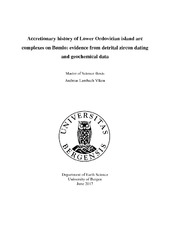Accretionary history of Lower Ordovician island arc complexes on Bømlo: evidence from detrital zircon dating and geochemical data
Master thesis

View/
Date
2017-06-13Metadata
Show full item recordCollections
- Department of Earth Science [1040]
Abstract
The provenance studies of sedimentary sequences associated with island arc complexes on Bømlo within the ophiolitic terrain of SW Norway has demonstrated that the provenance signature of these sedimentary rocks changed dramatically with time. The results provide new information about the source of these sediments and on the accretionary history of the associated island arc complexes. On top of oceanic crust, there were extrusion of island arc tholeiitic island arc volcanics (the Geitung Unit). Detrital zircons from a sedimentary sequence associated with this immature island arc are dominated by ages around 494 Ma, which is consistent with the 494 ± 2 Ma age of basaltic-andesites from the same immature island arc. This suggest only a local source of the sediments, which indicates that the immature island arc was far away from a continental margin at this stage. In contrast, a sedimentary sequence associated with a later, more mature island arc system, are dominated by zircons of Archean (~2700 Ma) and Paleoproterozoic (~1900 Ma) ages, together with minor populations of Meso/Neoproterozoic (~1000 Ma) and Cambrian-Ordovician (~500 Ma) ages. This provenance signature is similar to migmatites and S-type granites that became accreted with the mature island arc system around 474, suggesting that these, or similar rock complexes, were a source for this sedimentary sequence. Simultaneously, there where extrusion of subaerial high-K calc-alkaline volcanics at 473 ± 2 Ma (the Siggjo Complex). The large Archean population of grains in the sedimentary sequence indicates that the ophiolitic terrain of SW Norway was close the Laurentian margin in the early Ordovician. During 20 Ma, the island arc complexes on Bømlo evolved from a tholeiitic island arc to a more mature calc-alkaline island arc complex, formed adjacent to the Laurentian continental margin. A Lower Silurian transgressive sequences, deposited on top of the deformed and eroded Lower Ordovician ophiolitic terrain shows predominance of Paleoproterozoic zircons, with a few grains of Archean age, probably derived from the ophiolitic substratum and associated granitoids. This indicates that the ophiolitic terrain in SW Norway was in contact with the leading edge of Baltica in early Silurian times.